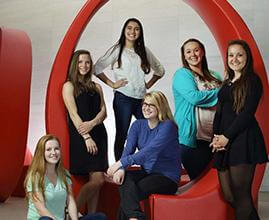 This was a different residents’ noon conference. Gone was the usual shuffling of papers and finger tapping of pagers, the cell phone calls and the side conversations between colleagues. The only words heard were those of the five teenage patients at the front of the room facing the residents. As the saying goes, you could have heard a pin drop.
This was a different residents’ noon conference. Gone was the usual shuffling of papers and finger tapping of pagers, the cell phone calls and the side conversations between colleagues. The only words heard were those of the five teenage patients at the front of the room facing the residents. As the saying goes, you could have heard a pin drop.
“My biggest fear, had I not gone to Hopkins, was waking up in a boring old hospital room with nurses checking my vitals every few hours, being given the bad news about my blood clot and collapsed lung without my parents in the room, having to go into the operating room alone,” said patient Stephanie Turner.
Added patient Brooke Szachnowicz, “The doctors here talked to me, which made me feel much more comfortable. It’s a lot easier when they talk to you instead of talking to your parents about you.”
The silence in the room may have had much to do with that point—seldom, it seems, do physicians speak one-on-one with their young patients about their care. That’s what this special “Patient- and Family-Centered Care Week” noon conference in mid-March was all about—hearing the pediatric patient’s voice to improve care.
“Often we think we know what will be good for them and project our ideas onto them,” says pediatric nurse Nadia Lauer, “but a lot of times we’re way off.”
“Without input from patients it’s hard for us as providers to help make the experience better, to do things that we might not think about without getting their perspective,” adds medical student Matt Molloy.
The patients’ insights at this noon conference also illuminated the purpose and early work of Johns Hopkins Teen and Children’s Council, or TACC—of which the noon conference panel are members.
“Part of the mission of the group is to continue efforts like this, to make sure the voice of teens is heard,” says Tricia Willis, a pediatric nurse who helped form TACC. “They see things through a different lens and really do bring a different perspective.”
“They don’t filter issues, they just tell you how it is, which is awesome,” adds Child Life specialist Gina Pizzano, a TACC member. “They really want to make changes.”
Telling it like it is and effecting “patient-centered” change is at the core of the group, now in its second year with 13 teenage patients—up from six in year one—and three Children’s Center staff members. They meet monthly, establishing goals like recruitment criteria for new members and creating opportunities to speak about their own experiences, a hallmark of patient- and family-centered care at Johns Hopkins. Group members also participate in fundraising and other activities for patients and families. One day they’re planning a homecoming dance in the hospital for adolescent patients, and the next participating in a panel discussion on transitioning to adult care.
“We have a full plate at each meeting,” says Willis. “We’re talking about extending the meetings to two hours because we don’t have enough time to cover everything.”
“They have so much energy and want to contribute in such a big way—it’s amazing to see how the group has evolved,” adds Pizzano.
To learn more about TACC or to apply for membership, email [email protected] or visit the TACC webpage at www.hopkinschildrens.org/Teen-and-Childrens-Council/.
Photo above: From left, TACC members Brenna Hohl, Brooke Szachnowicz, Rima Teymourlovei,Jordan Magsamen, Abbey Rhodes and Stephanie Turner in the Children's Center lobby.
This story by Gary Logan originally appeared in the 2015 edition of Hopkins Children's magazine.
